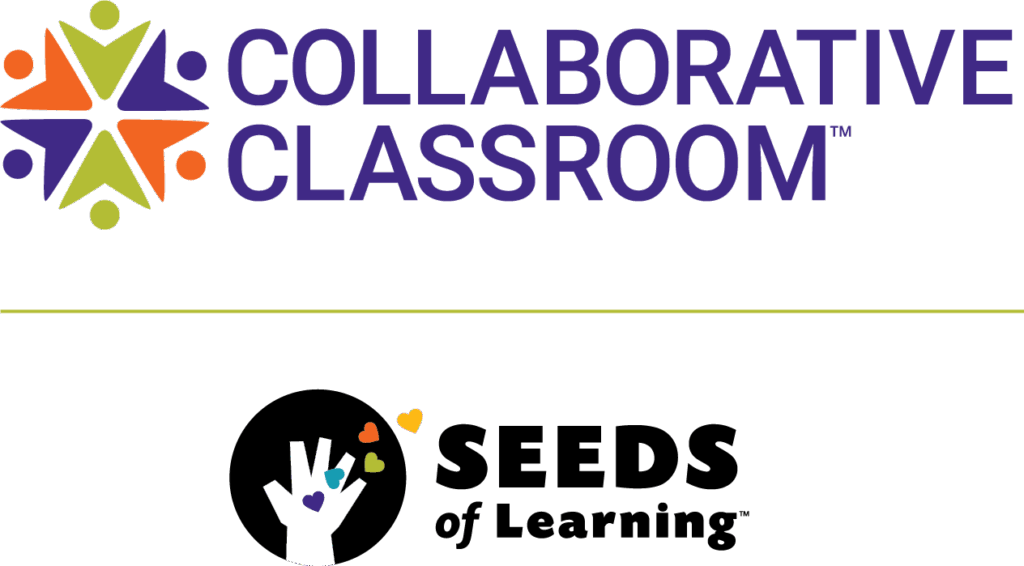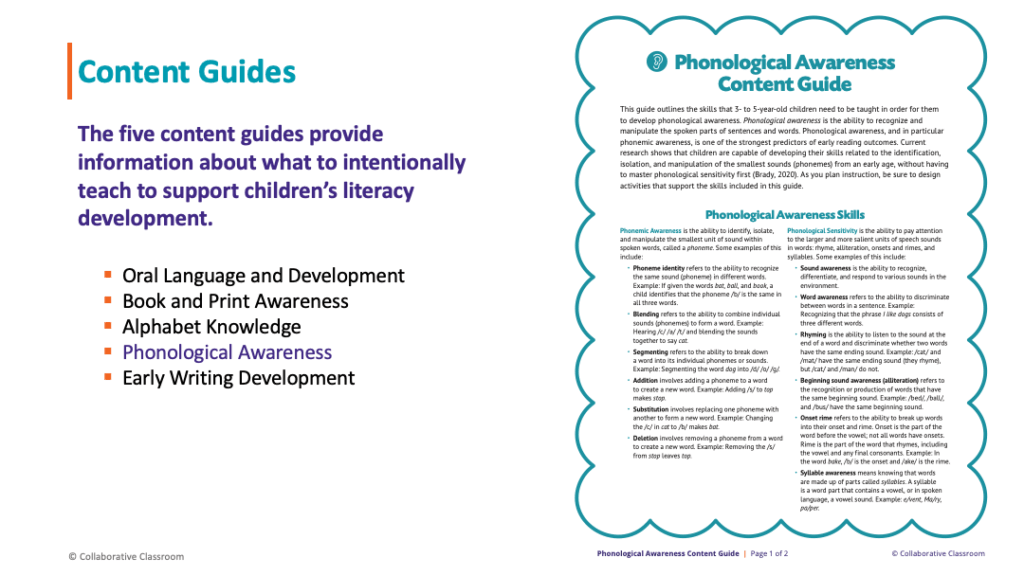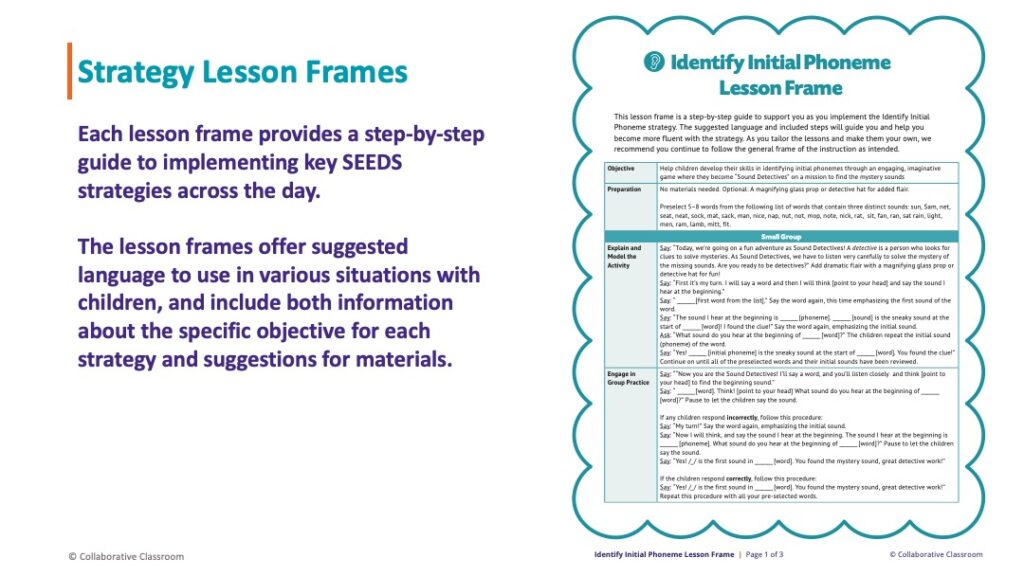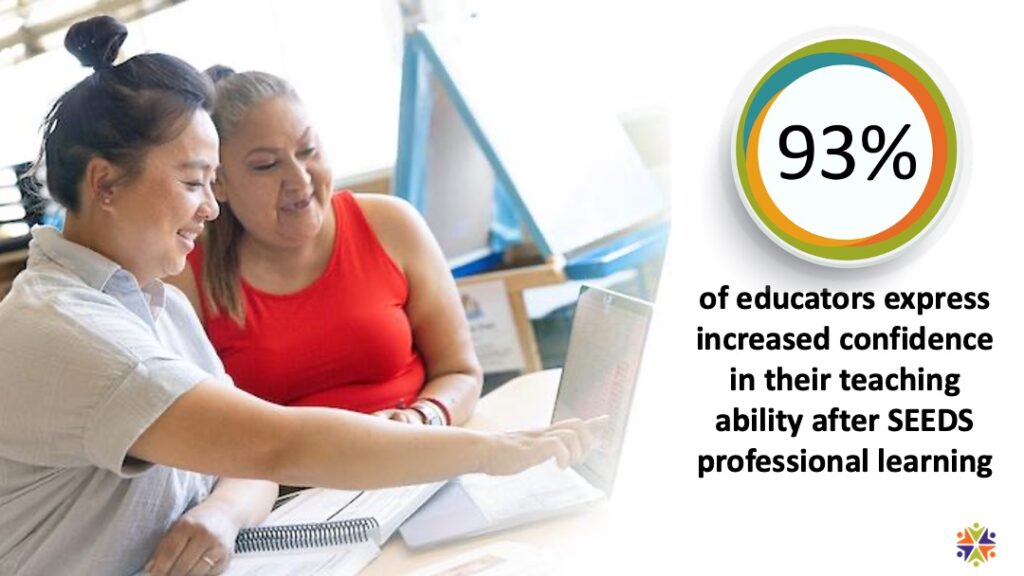
In a recent webinar, Collaborative Classroom program experts Emily Grunt and Gina Fugnitto provided an overview of the SEEDS of Learning professional learning framework and the SEEDS approach to building children’s foundational early literacy skills.
In this lively, condensed audio recording, Emily and Gina share all the latest updates for the SEEDS professional learning framework as well as exciting news for the 2025-2026 school year. Enjoy!
Listen and download the recording
SEEDS is a professional learning framework of strategies that combines sessions of learning with coaching. It focuses on the Big 5 early literacy skills that children need to become readers, as well as providing the social skills and self-regulation for students to be ready for kindergarten and readers by grade three.
SEEDS is an acronym
It is a grounding piece to help achieve a balance of relationship and quality interactions.
The first S in SEEDS stands for sensitivity:
- Being aware, asking questions, and tuning into a child’s needs and what we can provide for them.
- Using all of our five senses, we’re aware by looking, listening, and feeling.
- Being aware of a child’s needs helps build a solid relationship between child and educator.
The first E in SEEDS is encouragement:
- Using positive non-verbals; affirmations and praise.
By combining sensitivity and encouragement, educators help children enter into the educational space in their thinking brain instead of an emotional state.
The second E in SEEDS is education:
- Phonemic Awareness
- Phonics
- Fluency
- Vocabulary
- Comprehension
Students need the Big 5 early literacy skills to become readers.
D stands for the development of skill through doing.
- intentional play
- intentional activities
- large motor, small motor, outside, inside
Providing opportunities to practice what we have intentionally taught.
The last “S” in SEEDS stands for self-image.
When fostering quality relationships and practicing a SEEDS balance, educators help children develop self-confidence while feeling respected and capable. This quality interaction and balance is useful for not only the child to teacher relationship, but teacher to co-teacher, teacher to administrator, teacher to parents, families, and caregivers in the community.
A Randomized Control Trial
A randomized control trial was conducted by NORC out of the University of Chicago to measure SEEDS effectiveness. The results proved that when using this professional learning framework as designed, you can expect impacts of up to 2 to 3.5 months additional literacy learning.
These results are achieved through a combination of professional learning sessions, coaching, and data recording.
Quality Resources
Quality resources are important to take our learning and transfer it to practice.
SEEDS offers two different types of resources:
- print materials.
- digital resources.
Our printed Educator’s Kit was curated specifically to help you participate in the professional learning and to transfer learning to practice.
Our Learning Portal allows access to a wide range of digital resources that go even further to help in taking the SEEDS of Learning framework and putting it into practice in your day-to-day classroom.
A Closer Look into Professional Learning Sessions
The first thing to be determined is how you will engage in professional learning. There are multiple entry points to engaging in professional learning to help build knowledge across the SEEDS of Learning framework.
Will you engage in –
- the educator certification course?
- in-person sessions?
- virtual sessions?
This might not be your choice, it might be the choice of the organization or the district you’re working with.
Tools for Planning, Implementation, and Practice
There are five specific sessions that are offered in the professional learning framework.
The first one grounds educators in the SEEDS of Learning.
- What is important about SEEDS qualities
- How they help with instruction
- How they help with planning the kind of experiences students need
Sessions two and three delve deeper into language comprehension, and sessions four and five go deeper into word recognition.
The SEEDS Qualities Reflection Tool.
This tool helps educators consider:
- What does each child need?
- What does each class need as a whole?
- Are students ready to learn?
- Am I being sensitive and aware of their individual needs?
Each child enters an educational space with their own unique knowledge bank, from their homes or another center, so taking into consideration that every day is different and teachers have a lot on their plate, these quality reflection tools help educators take a breath to determine next steps to moving forward.
Content guides
There are five content guides that align with the SEEDS strategies.

What are those early literacy skills that we’re striving to develop for our youngest students?
As an example, phonological awareness is the content guide that ground sessions four and five. This is where educators gain content knowledge and understanding of the strategy that helps prepare for instruction.
Lesson Frames
Lesson frames provide a step-by-step guide for implementing those strategies. We offer suggested language, specific objectives, as well as suggestions around materials.

Continuing with session five and using the content guide example around phonological awareness, a lesson frame identifies initial phonemes.
We can take this frame into the classroom to help the children grow and develop in identifying initial phonemes. Reflecting is part of our planning.
As lesson frames help educators plan for class instruction – in this case identifying initial phonemes – every lesson frame also has a reflection tool for educators, coaches, and leaders, to help consider our strengths and where we can improve in teaching a certain strategy.
Coupling lesson frames and reflection tools helps elevate our practice and lead into decisions we want to make for our students.
Planning Tool
The planning tool helps consider differentiation and what repeated experiences each child will have. It helps plan activities for:
- Whole group
- Small group
- Individual
The planning tool helps educators scaffold and differentiate to meet the wide range of children in a classroom. It also help consider what co-teachers do as well.
The planning tool aids in working together and making decisions around moving around the classroom effectively and efficiently.
Repeated Read Aloud
The SEEDS Professional Learning Framework offers one more resource that’s a little bit different and specific to session three with its focus on language comprehension.
We know that a repeated read aloud is an important part of our work and navigating a multi-day read aloud can be tricky, particularly when taking on a new practice. SEEDS provides a higher level of scaffold with the repeated read aloud, offering 26 articulated repeated read aloud lessons for you to use all year.
The Collaborative Coach
Partnering coaching with professional learning helps elevates the transfer to practice. Collaborative Coach gives every educator a one-on-one coaching experience. A dedicated coach helps each educator curate their resources, consolidate their learning, think about their students, and take the practice into their daily work.
The coach helps me think about the children in my classroom
- Where are they now?
- Where are they going to be in three months?
- How can we adjust the lesson frame to best meet their growing literacy needs?
Data
Data is the third component of SEEDS and grounds all the work that we do. The data is part of the professional learning experience and a driving force behind coaching considerations.
Data is what communally brings us together as a community of educators. Data aids in considering how we come alongside the children in our classrooms and how we continue to help them develop.
SEEDS Confidence Rating
We are proud to share the fact that 93% of educators feel an increased level of confidence in their own teaching ability after they’ve engaged in SEEDS professional learning.

Survey results from recent professional learning sessions:



An Exciting Announcement!
In addition to our SEEDS of Learning professional learning framework, we are honored and excited to announce that for the 2026-2027 school year, we will offer The SEEDS of Early Literacy: A Curriculum for Children ages 4 to 5.
This curriculum provides another important pathway for the early childhood space where educators and decisions-makers can choose the kind of SEEDS work that best meets the needs of each organization.
Download Samples of SEEDS of Learning
Professional Learning Framework Sample Kit
